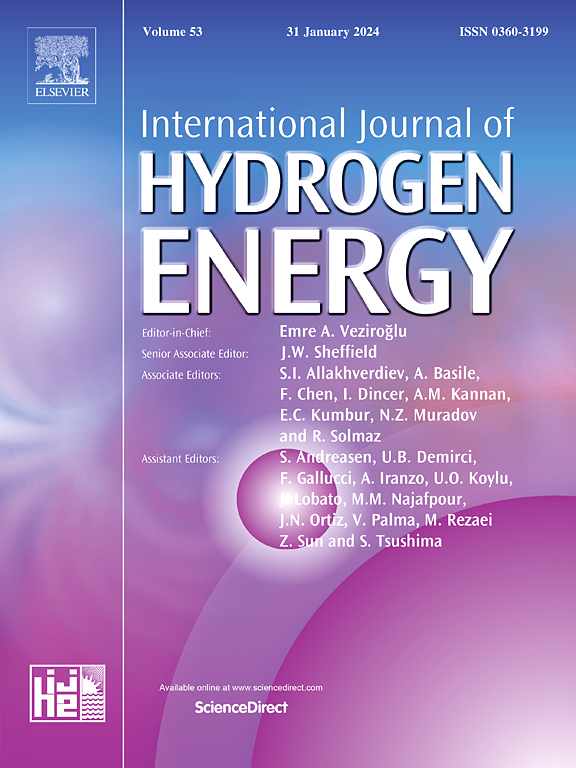油菜秸秆超临界水气化制氢技术经济分析
IF 8.1
2区 工程技术
Q1 CHEMISTRY, PHYSICAL
引用次数: 0
摘要
利用可再生能源生产氢气越来越受欢迎,以减少我们对不可再生化石燃料的依赖,以满足日益增长的氢气需求。然而,尽管通过超临界水气化(SCWG)从可持续来源(如木质纤维素生物质)生产氢气的前景广阔,但它尚未在大规模工业规模上商业化。这是由于缺乏木质纤维素生物质的SCWG详细的经济分析,由于SCWG过程的复杂性和生物质的异质性。因此,为了解决这一知识差距,在本研究中,对一个概念性SCWG试点进行了详细的技术经济分析(TEA),该试点能够处理200吨/天的油菜籽秸秆以生产绿色氢。利用实验数据,利用Aspen Plus®模拟进行概念中试物的质能平衡,在500°C、23 MPa、10 wt%的优化反应条件下,氢气产率为41.62 mmol/g。利用SuperPro软件进行了基于计算的质量和能量平衡的经济分析。资本支出(CAPEX)为8100万美元的现金流分析显示,内部收益率(IRR)高达38.9%,未贴现净现值(NPV)为5.48亿美元。据估计,生产氢气的最低销售价格(MSP)为3.38美元/千克氢气,低于其他可再生制氢工艺,与不可再生制氢技术相当。较高的正IRR和NPV,而较低的MSP表明,尽管技术准备水平(TRL)较低,但木质纤维素生物质的SCWG在技术上和经济上都是可行的制氢工艺。此外,敏感性分析还显示,资本支出(CAPEX)和油菜秸秆价格对净现值(NPV)和MSP的影响最大。然而,总体NPV和MSP对参数的变化高度稳定,突出了经济分析的稳健性。本文章由计算机程序翻译,如有差异,请以英文原文为准。
Technoeconomic analysis of supercritical water gasification of canola straw for hydrogen production
Production of hydrogen from renewable sources is gaining popularity to reduce our dependency on non-renewable fossil fuels to meet growing hydrogen demand. However, despite the great prospect of production of hydrogen from sustainable sources such as lignocellulosic biomass via supercritical water gasification (SCWG), it has not been commercialized at a large industrial scale. This is due to the lack of detailed economic analysis of SCWG of lignocellulosic biomass, owing to the complexity of the SCWG process and the heterogeneous nature of biomass. Therefore, to address this knowledge gap, in this study, a detailed technoeconomic analysis (TEA) of a conceptual SCWG pilot having the capacity to process 200 tons/day of canola straw for the production of green hydrogen was conducted. Mass and energy balance of conceptual pilot was performed using Aspen Plus ® simulation by utilizing experimental data and hydrogen yield of 41.62 mmol/g was obtained at optimized reaction conditions of 500 °C, 23 MPa, and 10 wt%. Economic analysis based on calculated mass and energy balance was performed using SuperPro software. Cash flow analysis for capital expenses (CAPEX) of 81 Million USD showed a high internal rate of return (IRR) of 38.9% and an undiscounted net present value (NPV) of 548 million USD. A minimum selling price (MSP) of 3.38 USD/kg H2 for produced hydrogen was estimated, which is lower than other renewable hydrogen production processes and comparable to non-renewable hydrogen production technologies. A high positive IRR and NPV, while a lower MSP showed that despite having a low technological readiness level (TRL) of 4, SCWG of lignocellulosic biomass is a technically feasible and economically viable process for the production of hydrogen. Furthermore, sensitivity analysis also revealed that capital expenses (CAPEX) and canola straw price had the highest influence on net present value (NPV) and MSP. However, overall NPV and MSP were highly stable to changes in parameters highlighting the robustness of the economic analysis.
求助全文
通过发布文献求助,成功后即可免费获取论文全文。
去求助
来源期刊

International Journal of Hydrogen Energy
工程技术-环境科学
CiteScore
13.50
自引率
25.00%
发文量
3502
审稿时长
60 days
期刊介绍:
The objective of the International Journal of Hydrogen Energy is to facilitate the exchange of new ideas, technological advancements, and research findings in the field of Hydrogen Energy among scientists and engineers worldwide. This journal showcases original research, both analytical and experimental, covering various aspects of Hydrogen Energy. These include production, storage, transmission, utilization, enabling technologies, environmental impact, economic considerations, and global perspectives on hydrogen and its carriers such as NH3, CH4, alcohols, etc.
The utilization aspect encompasses various methods such as thermochemical (combustion), photochemical, electrochemical (fuel cells), and nuclear conversion of hydrogen, hydrogen isotopes, and hydrogen carriers into thermal, mechanical, and electrical energies. The applications of these energies can be found in transportation (including aerospace), industrial, commercial, and residential sectors.
 求助内容:
求助内容: 应助结果提醒方式:
应助结果提醒方式:


